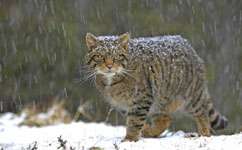Scientists identify essential wildcat habitat

Woodlands and grasslands that support rabbits and small rodents should be protected if we are to save the wildcat, say scientists.
Researchers used data from the Scottish Wildcat Survey (2006 to 2008), and the National Biodiversity Network (NBN) Gateway to identify the cats' favoured habitat. The NBN is an online tool which makes information about biodiversity in the UK freely available to researchers.
They discovered that wildcats are much more likely to be found in a mixture of woodland and large grassland areas, which are home to rabbits and small rodents like mice, rats and voles. Surprisingly, they found that the cats don't necessarily avoid people, and are even sometimes found in some hunting estates.
The findings provide some of the first insights into the types of habitat preferred by the Scottish wildcat population.
The team's results back findings from previous studies across mainland Europe which showed that the availability of prey has a large effect on the cats' distribution. They also provide further evidence that the wildcat is not primarily a forest species, as scientists previously thought.
European wildcats look like heavily built, tabbies with thick, blunt-tipped tails with prominent tail rings, They tend to be bigger than domestic cats, with longer legs and bulkier bodies.
The wildcat is found throughout Africa, Asia and Europe, and is classified as 'Least Concern' on the IUCN Red List of Threatened Species. But the feline faces a barrage of man-made threats like habitat loss, persecution, and a shortage of prey. The biggest threat comes from inter breeding with domestic cats, which dilutes the genetic integrity of the purebred wildcat population.
Conservation is a priority
The situation is so bad in Scotland that some scientists estimate that only 400 wildcats exist in the country's north and central areas. Although scientists don't yet have a definitive number, results from recent surveys suggest that the cats' numbers could be even lower than this, making conservation a priority.
Researchers have previously recommended setting up so-called Special Areas of Wildcat Conservation.
'But to do this, you need to have a thorough knowledge of the environmental requirements of the wildcat to identify the most suitable areas,' says André Silva from the University of Lisbon, lead author of the study.
Until now, few studies have focussed on finding out which habitat is essential for the Scottish wildcat population. The few studies that did look at the wildcat's ecological requirements found that they prefer places where you'd also find rabbits. Other studies have shown that the cats can exist in rabbit-free habitats, as long as they can prey on other small mammals and birds.
So Silva and colleagues from the universities of Lisbon and Oxford set out to settle the matter.
They found that the spread of wildcats across Scotland was dependent on both prey availability and landscape. As well as regions that are rich in grasses, the cats tend to frequent woodland areas. In contrast, they don't seem keen on heather moorland, regions with little grassland, and more mountainous areas.
'Our study suggests that landscapes which include grasslands and woodlands should be a priority for wildcat conservation efforts,' says Silva.
Silva and his colleagues used land-cover maps downloaded under an open access licence from the Natural Environment Research Council's (NERC) Centre for Ecology & Hydrology (CEH) gateway.
The study is published in Biodiversity Research.
More information: Silva, A. et al. Wildcat occurrence in Scotland: food really matters, Diversity and Distributions Volume 19, Issue 2, pages 232-243, February 2013, published online 9 November 2012, DOI: 10.1111/ddi.12018
Journal information: Diversity and Distributions
Provided by PlanetEarth Online
This story is republished courtesy of Planet Earth online, a free, companion website to the award-winning magazine Planet Earth published and funded by the Natural Environment Research Council (NERC).




















